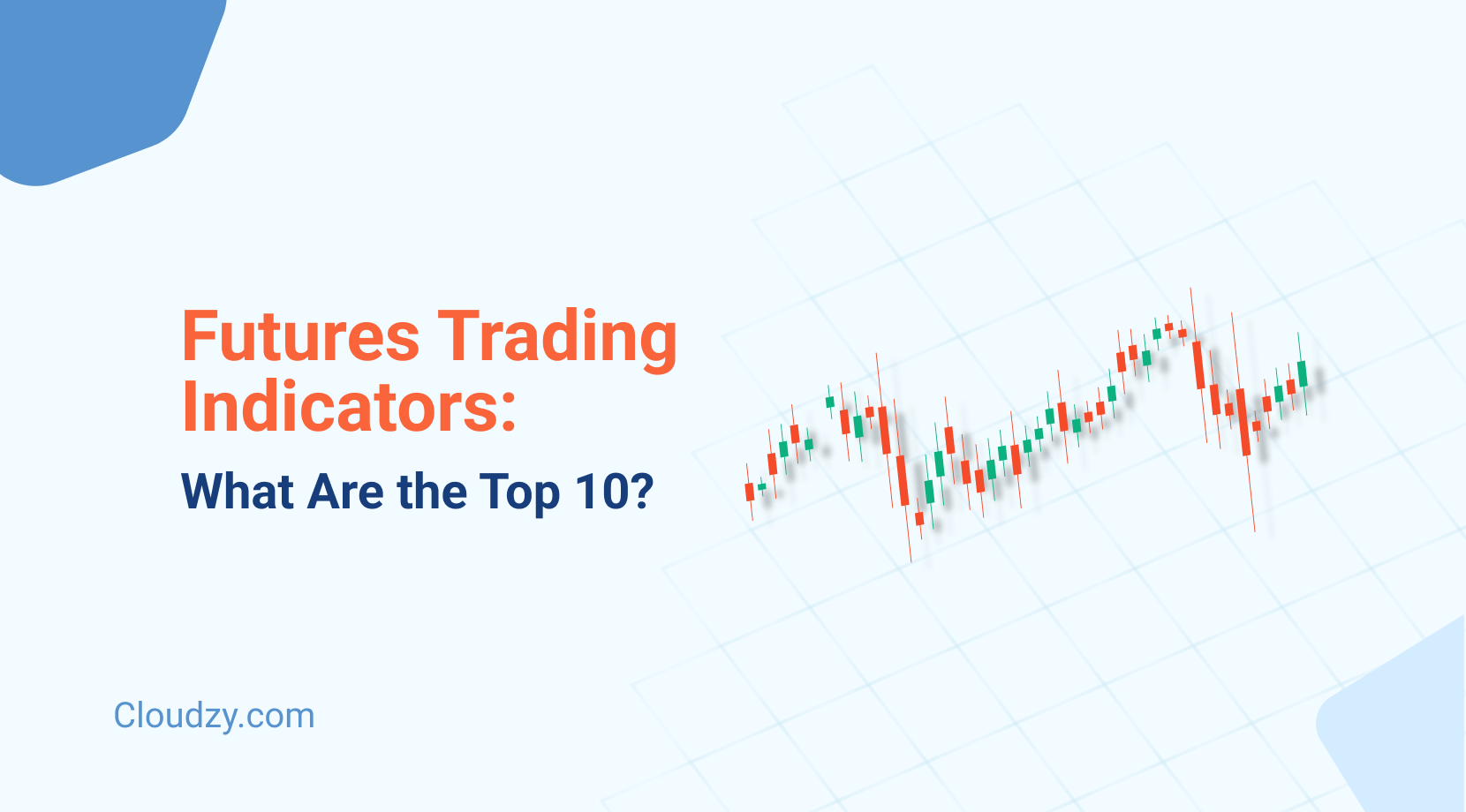The most effective futures trading indicators for 2025 include moving averages for trend direction, RSI for momentum analysis, VWAP for volume-weighted positioning, and ATR for volatility measurement. These technical indicators help futures traders identify optimal entry and exit points while managing risk in volatile markets.
Look, I’ll be straight with you about understanding what futures trading is – you’re stepping into a world where milliseconds determine whether you’re profitable or explaining losses to your spouse. Technical indicators aren’t mystical crystal balls, but they transform chaotic price data into something workable instead of pure guessing.
Academic research shows that 56 of 95 studies concluded technical analysis produces positive results. Not exactly a slam dunk, but better odds than most get at casinos. Most surviving traders stick with 2-4 complementary indicators rather than loading charts with every tool imaginable.
- What Are Trading Indicators?
- The 10 Essential Futures Trading Indicators
- Moving Averages (SMA/EMA) - Your North Star
- RSI (Relative Strength Index) - The Mood Ring
- MACD - Simple but Deadly Effective
- Bollinger Bands - Market's Mood Swings
- VWAP (Volume Weighted Average Price) - Following the Elephants
- ATR (Average True Range) - Your Risk Compass
- Stochastic Oscillator - The Wingman
- Fibonacci Retracement - Mathematical Psychology
- Volume Profile - X-Ray Vision
- Ichimoku Cloud - The Swiss Army Knife
- How to Combine Indicators for Better Accuracy
- Common Mistakes When Using Indicators
- Which Indicators Work Best for Different Strategies?
- FAQ
What Are Trading Indicators?
Technical indicators for futures are mathematical formulas that process price, volume, or open interest data into digestible insights. Think of them as translators – they turn market chaos into whispered suggestions about momentum, trend direction, and potential reversals.
How Technical Indicators Work in Futures Markets
Three camps matter: Trend indicators like moving averages show which way the river flows. Momentum indicators such as RSI measure current speed – handy for spotting overheated conditions. Volume indicators including VWAP reveal where big fish swim, crucial since they move these markets.
Smart money matches indicators to market personality. Trending markets love moving average crossovers. Choppy sideways action? You’ll get sliced up faster than vegetables in a Cuisinart.
The 10 Essential Futures Trading Indicators
After watching countless traders blow up their accounts (and admittedly making a few expensive mistakes myself), certain indicators consistently separate the survivors from the casualties. These tools handle leverage, volatility, and time decay without falling apart when markets get ugly.
| Indicator | Best For | Key Signal | Default Setting |
| Moving Averages | Trending markets | Price above/below MA | 20, 50, 200 periods |
| RSI | Overbought/oversold | Above 70, below 30 | 14 periods |
| MACD | Trend changes | Line crossovers | 12, 26, 9 |
| Bollinger Bands | Volatility breakouts | Band squeezes/touches | 20 SMA, 2 std dev |
| VWAP | Institutional flow | Price above/below line | Daily reset |
| ATR | Position sizing | Volatility expansion | 14 periods |
| Stochastic | Momentum confirmation | %K/%D crossovers | 14, 3, 3 |
| Fibonacci | Support/resistance | 38.2%, 50%, 61.8% levels | Standard ratios |
| Volume Profile | Market structure | Point of Control (POC) | Session-based |
| Ichimoku Cloud | Complete analysis | Price vs cloud position | 9, 26, 52 |
Moving Averages (SMA/EMA) – Your North Star
Moving averages smooth price noise to show underlying current. They’re the best indicator for futures trading when markets pick a direction and stick with it. EMAs react quicker, SMAs treat everything equally – both have their moments.
That 20-period EMA acts like a trusted friend pointing out obvious trends. Price above it? Bulls control. Break below and stay there? Time to reconsider your bullish bias.
RSI (Relative Strength Index) – The Mood Ring
RSI compares recent gains to losses over 14 periods, bouncing between 0 and 100. Above 70 means everyone’s drunk on optimism, below 30 suggests panic selling might be overdone. Markets can stay “drunk” longer than your risk tolerance allows though.
Real magic happens with divergence. When crude makes new highs but RSI shows lower peaks, that’s your canary singing off-key. Something’s wrong, even if price hasn’t figured it out yet.
MACD – Simple but Deadly Effective
MACD combines two exponential moving averages (12 and 26 periods) with a 9-period signal line. Buy when MACD crosses above signal line, sell on downward crosses. The histogram shows whether momentum’s accelerating or hitting brakes.
Nothing fancy, just clear visual signals tough to misinterpret, even after staring at charts for 12 hours straight.
Bollinger Bands – Market’s Mood Swings
Elastic bands around price that stretch during wild times, squeeze during boring periods. That “Bollinger Squeeze” is like watching a coiled spring – something’s got to give, usually violently.
When bands contract to pencil-thin widths, pay attention. Subsequent breakouts with decent volume often create moves that make your coffee go cold.
VWAP (Volume Weighted Average Price) – Following the Elephants
VWAP shows average price weighted by volume – where institutional elephants stomped. With global foreign exchange moving $7.5 trillion daily, this volume indicator helps avoid swimming against their current.
Price above VWAP? Big money’s buying. Below? They’re selling or sitting idle.
ATR (Average True Range) – Your Risk Compass
ATR measures volatility without caring about direction. Transforms position sizing from “feels right” to actual math.
If ES futures show 14-day ATR of 45 points, setting stops at 1.5x ATR gives trades breathing room without letting losses run wild.
Stochastic Oscillator – The Wingman
Stochastic compares closing prices to recent ranges, creating %K and %D lines. Works best as backup confirmation rather than primary signal generator.
Watch for %K crossing above %D in oversold territory, but only with trend tailwinds. Fighting major trends with Stochastic is like swimming upstream in hurricanes.
Fibonacci Retracement – Mathematical Psychology
Golden ratio levels (23.6%, 38.2%, 50%, 61.8%, 78.6%) become self-fulfilling because thousands watch the same spots. Like everyone agreeing to meet at the same coffee shop without coordinating.
The 50% and 61.8% retracements pack most punch, especially when aligning with other support/resistance or chart patterns.
Volume Profile – X-Ray Vision
Shows where heavy trading occurred at each price level. Point of Control (POC) marks where most volume changed hands – battle scars from previous price wars.
High volume areas become gravitational fields. Low volume zones? Price blows through like they’re not there.
Ichimoku Cloud – The Swiss Army Knife
Combines five components into comprehensive system. Looks complicated initially, but gives trend, momentum, and support/resistance in one glance.
Price above thick cloud? Bulls drive the bus. Inside thin clouds? Welcome to no-man’s land where anything happens.
How to Combine Indicators for Better Accuracy
Here’s where most mess up – they either treat one indicator like the holy grail, or pile on so many their screen looks like a rainbow exploded. Neither works.
Understanding how to use indicators in futures means building systems where tools confirm each other’s stories. Futures trading algorithms use what I call the “three-leg stool”: trend filter (200-day EMA), momentum confirmation (RSI divergence), and volume validation (VWAP positioning).
Signal confirmation saves accounts. If Bollinger Bands scream “breakout” but RSI shows bearish divergence while volume yawns, smart money waits.
Common Mistakes When Using Indicators
Over-optimization kills more accounts than bad luck. Avoid:
- Tweaking parameters until finding magical backtesting indicators results
- Trading when RSI says buy but MACD screams sell
- Single indicator dependence without confirmation
- Using 14-period RSI on 1-minute charts (pure noise)
Markets don’t care about perfect backtests. They care about what’s happening now.
Which Indicators Work Best for Different Strategies?
Strategy selection determines tool choice. futures indicator strategies must match your trading personality and market mood, not rigid textbook approaches.
Day Trading Indicators for Futures
Day trading indicators for futures need speed over smoothness. Knowing what time futures markets open affects choices – pre-market gaps need volume confirmation, regular sessions favor momentum plays.
Scalpers combine fast EMAs (5, 13) with quick RSI (9-period) for rapid signal confirmation. VWAP trading during first hour aligns with institutional flow when algorithms execute large orders.
Swing Trading Combinations
Futures trading strategies for swing trading emphasize catching bigger moves over quick scalps. Weekly and daily timeframes filter noise that drives day traders crazy.
Swing traders pair 50-day and 200-day EMAs for trend bias with weekly RSI for timing. Fibonacci retracements work particularly well – major pullbacks often find support exactly where math suggests.
Automated Trading Integration
Some indicators translate into code better than others. Moving average crossovers, RSI thresholds, and Bollinger Band breaks provide clear binary signals computers execute without human interpretation.
NinjaTrader VPS hosting keeps algorithms running when internet takes coffee breaks. Forex VPS solutions work equally well for futures algorithms, providing redundancy individual traders struggle achieving.



